|
Polar
Priorities and Membership
News
Archive
of Past Articles
|
Bolling Byrd Clarke, 1922-2007, daughter of famed Polar
explorer Admiral Byrd and Society board member
 |
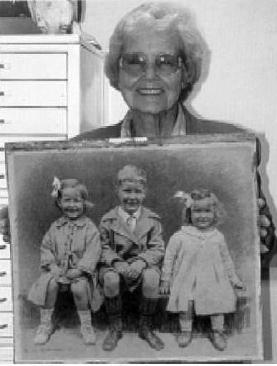 |
| BOLLING BYRD CLARKE 1997.
1922 - 2007
|
Bolling helped organize
her father’s papers for the
Byrd Polar Research
Center Archives at Ohio
State University. She is
shown with a photo of her
and her siblings, circa
1920s. |
|
Bolling Byrd Clarke, 1922-2007, daughter of famed Polar
Bolling Byrd Clarke, the daughter of famed Polar
explorer Admiral Richard E. Byrd and an active member
of the board of the Frederick A. Cook Society for a
decade, died on November 3 at the University of
Pennsylvania Hospital.
Bolling (her name was on one of the ships in the
early Byrd expeditions to Antarctica in the 1930s) was
present last summer when a new US Navy vessel bearing
her father’s name was launched in San Diego’s shipyard.
That, her family said, was one of her proudest moments,
the other highlight being a visit to the Antarctic in 1989.
Bolling was educated at Windsor School in
Brookline, MA. During WWII she volunteered her
services to the nation and became a hand on a Maine
farm milking cows and tending other livestock. After the
war she was employed as a technician at Harvard Medical
School’s Department of Anatomy, and went on to become
a pre-med student at Swarthmore College in Swarthmore.
Married to William A. Clarke Jr. in 1947 (she was
divorced 1969), she cut short her studies to stay home
and raise her children, Evelyn Byrd Clarke, Made Ames
Clarke, Eleanor Stabler Clarke II and Richard Byrd.
>
READ
THE FULL ACCOUNT
Sir Wally Herbert: he followed Cook and Peary
|
British polar icon Wally Herbert died June 12 at
age 72. The third expedition to walk to the North
Geographic Pole, Wally and his men continued across
the Arctic Ocean in a monstrous trip that included overwintering
on the ice in 1968-69.
Wally’s polar life was marked by human ambition
and controversy typical for Arctic explorers of the
time. In 1908, American-born Frederick Cook claimed
to be the first to have reached the North Pole. Fellow
American Robert E Peary said he reached the pole the
next year, disputing Cook and claiming the first for
himself. Next to reach the spot was Wally Herbert in
1969, soon disputing
Peary. With that the North Pole
“first” got its third contestant (not including a number
of accompanying team members and local
Inuits).
The will to be the first
With a Norwegian first to ski to the South Pole,
Nepal/New Zealand first to summit Everest, Soviets
first to fly to space and Americans first to walk on the
moon - Wally’s dispute of Peary gained many fans
among his countrymen (often with inflated claims) and
the North Pole debate rages to this day. |
|

Wally was a doubter as far as the North Pole
was concerned. He did not believe that either Cook or Peary got there, but his earliest
opinions were decidedly
for Cook, as in his
1970 book, The North Pole. |
>
READ
THE FULL ACCOUNT
|
|
New ‘Admiral Byrd’ is commissioned
| On May 15 Society board member Bolling Byrd Clarke, daughter of legendary 20th century Polar explorer Admiral Richard E. Byrd, broke the ceremonial bottle of champagne on the bow of the newly-commissioned USN Richard E. Byrd at the San Diego naval shipyard.
USNS Richard E. Byrd (T-AKE-4) is a Lewis and Clark-class dry cargo ship in the United States Navy. She is the second United States Navy ship to be
named after rear Admiral Richard E. Byrd.
|
 |
 |
| Donald
Winter,
Secretary of
the Navy,
Matron of
Honor Marie
Giossi,
Admiral
Richard E.
Byrd’s
daughter and
Ship’s
Sponsor
Bolling Byrd
Clarke at
launching.
The contract to build her was awarded to National Steel and Shipbuilding Company
(NASSCO) of San Diego, California, July 2003. She was launched from the building ways into the San Diego Bay. Bolling Byrd Clarke, Admiral Byrd’s eldest daughter
broke the ceremonial bottle of champagne on the ship’s bow to start the launch amid fireworks and fanfare. The ship is scheduled to be part of the Pacific Fleet.
The first United States Navy ship to be named after Admiral Byrd was the
USS Richard E. Byrd (DDG-23) a
Charles F.
Adams-class guided missile destroyer. |
Two Commemorative Cook US Postal stamps for 2008
Two commemorative stamps will be
issued this year as part of the United
States Postal Service commercial
photo stamp program, both to mark the
centennial of the discovery of the North
Pole in April 1908. Two Commemorative Cook US Postal stamps for 2008.
The first stamp depicts Cook from
the 2000 Arts & Entertainment cable
documentary series on “The Race
for the Poles.” The inscription on the stamp
is “Frederick A. Cook, Discoverer of the
North Pole, April 21, 1908.”
The companion stamp is a
reproduction of a rendering from the
book Finding the North
Pole, which was published in late 1909 after Cook
had returned to the United States from
the Arctic via Copenhagen. The
inscription is “Centennial of the
Discovery of the North Pole, April 21,
1908.”
Society members interested in
obtaining sheets of 20 stamps should
write the Society. They will be available
after July 1 by writing to Polar
Publishing Co., PO Box 11421,
Pittsburgh, PA 15238.
October
1997 forum hears of ‘Belgica’
Dr. T. H. Baughman, professor of
history at Oklahoma Central University
and author of Before the Heroes
Came: Antarctica in the 1890s
delivered a paper on Cook and
Amundson at the Workshop on the History
of Antarctic Research.
The
presentation was held
October 25 at the Byrd Polar Research
Center at Ohio State
University and was part of the forum on “National and
Transnational Agendas in Antarctic
Research from the 1950s and Beyond.”
While the agenda was
concerned with the second half of the 20th century, the
Baughman paper was selected to
place into perspective modem South
Polar exploration and research.
The “Belgica” expedition of 1897-
99 was the first multi-national and
interdisciplinary expedition to winter
the Antarctic. Amundson as First Mate
and Cook as surgeon-anthropologist
set the stage for their assault on both
Poles a decade later through their
South Polar experience.
The sponsoring group for the
Workshop, headed by Dr. Cornelia
Ludecke of Germany, says that “we
want to study what degree research in
the Antarctic has been driven by
scientific criteria and to what extent
compromises were made in the light of
political barriers and logistical
limitations. In historical perspective, a
review shall be made of essential
background factors at work, both
scientific and non-scientific ones, when
nations were moved to participate in the
IGY (1957-58). Additional background
factors will be considered with regard
to major nations that chose not to
contribute to the IGY with expeditions.
April conference will hear scholars from Norway, Russia and Nunuvat
Explorers, researchers and historians from Russia, Norway and Nunuvat will participate in an international symposium that will discuss the attainment of the geographical North Pole on April 21, 1908 by Dr. Frederick A. Cook. The forum will be held at the Yale Club, located at 50 Vanderbilt at 44th St. in New York City, just opposite from Grand Central Station.
>
READ
THE FULL ACCOUNT
|
Fo
|
From
the May-June diary
of Oleg Banar on
McKinley
(Note:
This journal extract
is a companion piece
to our featured
article on the Mount
McKinley page.)
“We
are standing in
front of the
Denali Pass, and
through-winds are
passing via it as
through a tube.
Dr. Cook and
Barrill were also
shivering from
cold in this
place. Their silk
tent was stretched
near the rocks 200
meters from the
place of our Camp.
“
Let
us look at the notes
in the Diary of Oleg
Banar, the Leader of
our Jubilee
Expedition, carried
out 100 years after
the ascent of Dr.
Cook:
May
23, 2006.
We have ascended to
the crosspiece
(bridge) between the
Peak 11,000 feet
andthe Peak 10 370
feet. From this
bridge we turned to
the familiar shelf,
which we know from
last year’s
expedition, and
following it we
ascended to the East
Ridge to the right
of the Peak 11,000
feet”.
Then
the mountaineers
started to move
along this crest to
the Traleika Col,
but their route was
blocked by an
unstable snowy peak,
made out of newly
drifted snow and
snow cornices. They
did not manage to
come out to the
Traleika Col.“
>
READ
THE FULL ACCOUNT
Cook’s
Letter and Map to
the Danish Governor
of Greenland
by
Warren Cook, Sr.,
President Frederick
A. Cook Society
Last
January the Society
received a letter
from Ida Thron
Mardal of
Copenhagen, Denmark,
telling abouta
letter written by
Dr. Cook,
accompanied by a
map, which was
presented to the
then Governor of
Greenland, Nicolai
Thron in 1909.
This
was a year of
Cook’s return from
northern Greenland
along the west coast
of the huge island,
then under Danish
sovereignty, and his
ultimate departure
to Copenhagen where
he was hailed as the
discoverer of the
North Pole. Cook has
several references
to his month at the
residence of the
Governor General
Kraul in Upernarvik
during May and June,
1909.
Governor
Thron’s
granddaughter
indicated that the
letter and map would
be of interest to
the Society, but it
went to auction in
Copenhagen and was
purchased in March
of 2006. Mrs. Mardal
sent a copy of the
letter and the map
which was drawn by
Dr. Cook, to myself
a few weeks ago.
>
READ
THE FULL ACCOUNT
.Articles
from 2007 Membership
News
Museum
Crisis sparks Cook,
community
cooperation
A
trend in
many smaller
communities
throughout
the United
States-rising
costs for
public
service
agencies and
building-caught
up with
Sullivan
County in
the Catskill
region of
New York
State this
year.
One of the
issues
affecting
the
Frederick A.
Cook Society
was the
possible
closing of
the Sullivan
County
Historical
Museum, home
for the
Society
since 1974
and the
location of
its
refurbished
F. A. Cook
Room, the
collection
of various
papers and
the personal
library of
Dr. Cook,
involving
several
hundred
books and
documents.
>
READ
THE FULL
ACCOUNT |
 |
Who
was first? US News
revives the North
Pole debate
"Who
was first?"
Polar historians and
those who know the
Cook and Peary
stories have been
familiar with that
for almost a
century. This past
year the question
because part of a
cover story on US
News and World
Report (August
14, 2006) and
resulted in a letter
fro the Society in a
subsequent issue.
Board member Marcia
Hutchinson of
Golden, CO, a
great-grand-daughter
of the explorer,
alerted the Society
of the advance issue
and the resultant
exchange.
>
READ
THE FULL ACCOUNT
|
|
Cook's
1909 return to New
York found in
painting
The
Oscar II, one
of the finest of the
passenger liners of
the Danish-American
Steamship Company,
arrived off Fire
Island near New York
Harbor on the
afternoon of
September 21,1909
after a nine-day
voyage from
Copenhagen. A salute
of guns from the
fort at
Christianland, by
order of King
Haakon, highlighted
the transfer of what
was then the world's
foremost explorer to
the great liner at
the start of the
journey.
After
a week of collecting
the highest awards
and tributes of the
Danes, Frederick A.
Cook was now coming
home. The reception
would rival that of
his European hosts,
who had a special
interest in his
achievement as
Greenland was a part
of Denmark and its
most northwesterly
shores had been the
base camp for Cook's
historic expedition
to the North Pole
and his dramatic
return in the Spring
of 1909, after most
had considered him
lost in the Arctic
wastes.
>
READ
THE FULL ACCOUNT
.Article
from the 2005 Issue of
Membership News
On
September 23,1909,
Frederick A. Cook
was presented a Gold
Medal for the
Discovery of the
North Pole by the
Arctic Club of
America. The event
was captured in a
wide-angle
photograph of 1,000
guests in the
ballroom of the
Waldorf-Astoria
Hotel in New York,
two days following
Cook's triumphant
return to the United
States from Denmark
and the Polar
Regions.
Both
events were
represented in the
2005 number of Polar
Priorities. The
whereabouts of the
Gold Medal has
eluded interested
writers and
scholars, as well as
the family for much
of a century since.
This month part of
the mystery was
resolved....
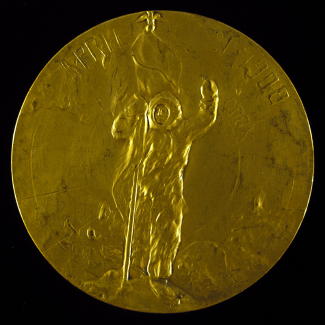 |
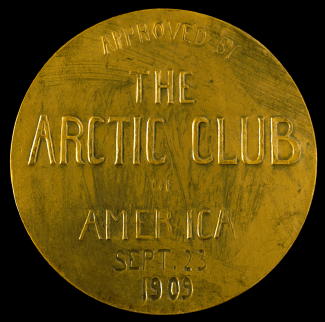 |
Arctic
Club of
America Gold Medal
Presented
to Dr. Cook
on September
23, 1909. |
>
READ
THE FULL ACCOUNT
|
|
|
‘True North’ study favorable to Cook claims
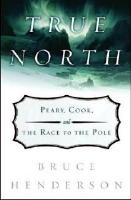 |
|
They had started out as friends and shipmates, with Cook, a doctor, accompanying Peary, a civil engineer, on an expedition to northern Greenland in 1891. Peary’s leg was shattered in an accident, and without Cook’s care he might never have walked again. But by the fall of 1909, all the goodwill was gone. Peary said he had reached the Pole in April 1909; Cook scooped him, presenting evidence that he had gotten there in 1908.
~ True North |
Bruce Henderson, a non-fiction writer whose books have appeared on the New York Times best-seller lists, and who was previously acclaimed for his work on the ill-fated Polaris expedition, has authored a new work on the Cook-Peary expedition. True North: Peary, Cook and the Race to the Pole (W.W. Norton) will be published in February 2005.
Henderson’s narrative, which is reviewed in this issue of the journal on page 46, is conclusive toward a favorable assessment of the North Pole priority of Frederick A. Cook with six specific arguments:
>
READ
THE FULL ACCOUNT
Cook reflections on early Antarctic exploration Toward the South Pole: Antarctic Voyages of Exploration From the Earliest Times to the Departure of the
Belgica
This is the title of the unpublished manuscript Bette Hutchinson, Dr. Cook’s granddaughter recently donated to the Ohio State University’s Byrd Polar Research Center Archival Program. According to Dr. Cook’s handwritten notes that accompany the documents, the manuscript was a ten-year project, finally completed on the Belgica in 1898. Dr. Cook states further, “(this is) valuable because material here given has been largely ignored by later history. Compare with Hayes and other
Antarcticans. Here discoveries are cited in words of the explorer. This should be set into a book.”
>
READ
THE FULL ACCOUNT
‘Terrae
Incognitae’ Journal reviews
Koryakin’s Russian biography of Cook
Termed by a reviewer as a “notable piece of Polar exploration scholarship”, by Dennis Reinhart of the University of Texas, the Russian biography of Cook by
V.S. Koryakin,
Frederick Albert Cook, 1865-1940 was reviewed in the 2004 number of the Journal of the Society for the History of Discoveries,
Terrae Incognitae volume 26.
Highlights from the Reinhart review follow: “ Few people outside the circle of those with a real interest in polar studies know of the American Dr. Frederick Albert Cook. He is nevertheless a significant figure in the history of polar exploration, and a controversial one as well. Born and educated in New York, he first went to the Arctic with Robert E. Peary, 1890-1892 as his surgeon. Thereafter, Cook was a participant in the seven other international Arctic and Antarctic expeditions through 1909.
>
READ
THE FULL ACCOUNT
|
|
The
Frederick A.
Cook Living
Museum:
Cook’s
1908-9
Winter Den
Cape Hardy,
Devon Island
by
Louis O.
(Lon)
Constantini
|
|
Exploring
the high
arctic is a
wonderful
experience
even when
challenged
by weather
and terrain.
However,
there is a
definable
and
recurring
experience
that I
always enjoy
the most.
Upon
arriving at
some arctic
location, on
ice or
gravel bank,
the most
pleasurable
time is when
the
DiHaviland
twin engine
Otter has
it’s
engines
rev’ed to
takeoff
pitch; the
plane rolls
forward and
in a space
less than I
can kick a
rugby ball,
it’s huge
tires leave
the ground.
The plane
lifts off,
and in this
instance
flies
towards the
cliffs,
pivots on a
wing tip and
then, as is
customary,
roars over
our heads.
In the time
it takes to
lift a
rucksack, it
looks like a
bird lost in
a cloud. It
would be
gone, and we
would still
be there.
>
READ
THE FULL
ACCOUNT |
|
Russian
glaciologist
advocates Cook
priority
Vladislav
S. Koryakin, the
Polar historian of
the Russian Academy
of Sciences and a
glaciologist-scholar
who has researched
the pioneer efforts
of western explorers
to reach the North
Pole for more than
30 years, has
published the first
foreign-language
biography of
Frederick A. Cook.
Prof.
Koryakin, who
delivered a paper at
the Symposium on
“Cook
Reconsidered” at
the Byrd Polar
Research Center in
1993, has edited the
Russian editions of
Cook’s My
Attainment of the
Pole and Peary’s
The North Pole. He
has also assisted in
the translation and
editing of the works
of Amundson and
Freuchen in Russia.
He has published
several papers on
scientific and
historical themes
involving the
changing currents of
the North Polar
regions.
>
READ
THE FULL ACCOUNT
|
'My
Attainment':
same
response to
both
reprints
Same
endorsements
and reviews
for both
reprints on
the Internet
|
|
|
|
|
| The
Polar
Publishing
Co.
edition
sponsored
by
the
F.A.
Cook
Society |
 |
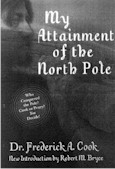 |
Bryce's
cover:
First
it
was
'North
Pole'
then
just
'Pole'
reflecting
the
mixed
agenda |
While
it may not
be the
first
instance
of
"copycat
publishing,"
it has
without a
doubt
introduced
confusion
into the
world of
internet
book
buyers,
with
special
emphasis
on those
who follow
the new
and
reprint
editions
dealing
with
classic
polar
exploration.
My
Attainment
of the
Pole,
Frederick
A. Cook's
account of
his 190709
North Pole
Expedition,
was
published
in 1911 by
Mitchell
Kennerley,
a
respected
New York
publisher.
While
Robert E.
Peary's
book, The
North Pole,
had come
out a year
earlier,
the
"Cook
book"
soon
gained a
popular
audience
on the
explorer's
Chatauqua
lecture
circuit
and
eventually
would
surpass
his rival
with three
editions
in the
United
States.
Editions
in the
United
Kingdom
and
Germany
soon
followed
and Cook's
book has
long been
considered
one of the
out-standing
accounts
of
exploration,
discovery
and
survival
in the
polar
regions.
>
READ
THE FULL
ACCOUNT
|
|
 |
Admiral
'Tommy'
Thomas,
Ice
Captain
of
both
polar
regions
in
war
and
peace |
He
captured the
first enemy
ship in
World War
II, was
called by
Admiral Byrd
as 'the best
ice sailor
alive' and
became
president of
the
reorganized
Frederick A.
Cook Society
in 1957.
Charles
Ward
Thomas
(19031973)
was quite
possibly
the
greatest
"ice
admiral"
of the
United
States in
the
twentieth
century.
He claimed
pioneering
experience
guiding
U.S. Navy
ships
through
the
treacherous
Arctic
Ocean
floes off
eastern
Greenland
and then
in the
Ross Sea
in
Antarctica.
President
Roosevelt
awarded
him the
Legion of
Merit for
heroic
service in
capturing
the first
enemy ship
in wartime
since the
Spanish-American
War, and
in
overcoming
a German
weather
service
base in
eastern
Greenland
in October
1944 with
the
surrender
of all of
its
personnel.
>
READ
THE FULL
ACCOUNT
What
happened to
the original
Andrew
Freeman
manuscript
in 1937?
.
|
The
son
of
Cook's
biographer
says
that
'powerful
forces'
stopped
its
publication
|
.
The
perspective
of a
youngster
not quite
nine years
old is
different
from that
of an
adult, so
my
reflections
on the
summer of
1936 in
the Hudson
River
community
of
Brewster
would be
far
different
from those
of my
parents.
They were
literary
people,
well
traveled
and
sophisticated
about the
world
which
judged the
lives and
deeds of
their
contemporaries
in harsh
standards.
My
father had
obtained
the notes
of a
previous
manuscript
on Dr.
Frederick
A. Cook by
a
contemporary
of Cook,
Felix
Riesenberg,
who had
served as
the
navigator
with
Walter
Wellman in
his famous
but
abortive
airship
expedition
to the
North
Pole. This
took place
in the
same year
that Cook
departed
for his
expedition
to the
Pole in
1907.
Riesenberg
had tried
to write
about the
CookPeary
controversy,
but all
his
sources
were
secondary,
and he
found that
there was
an extreme
reluctance
by those
who knew
both
explorers
to provide
their
conclusions
or even
recollections.
>
READ
THE FULL
ACCOUNT
The
Woman
Assistant
U.S.
Attorney
General and
the Prisoner
at
Leavenworth,
1928-29.
Called
the
"most
influential
woman in
America"
in the 20s,
Mabel
Willebrandt
was a key
advocate for
prison
reform and a
player in
the pardon
of Cook in
1930.
| The
trial,
imprisonment,
appeals
and
pardon
applications
of
Frederick
Albert
Cook
occupied
thousands
of
pages
of
Federal
Court
proceedings
for
eight
years
of the
second
decade
of the
last
century.
And
those
same
years
involved
the
career
of the
highest
ranking
woman
in the
federal
government,
Mabel
Walker
Willebrandt,
the
first
woman
Assistant
Attorney
General
of the
United
States.
Possibly
dismissed
by
many
political
historians
and
those
who
would
later
chronicle
the
women's
movement,
Willebrandt
had
the
unpopular
call
to
enforce
the
equally
unpopular
18th
Amendment,
which
amounted
to
enforcing
Prohibition
at its
highest
legal
levels
in the
"roaring
Twenties."
Born
on the
Kansas
prairie
in
1889,
Mabel
Walker
Willebrandt
began
school
at 13,
was a
teacher
at 17,
a
principal
at 22,
and a
lawyer
at 27.
Five
years
later,
at 32,
she
was
appointed
an
assistant
attorney
general
by
President
Harding,
heading
the
division
in the
Justice
Department
responsible
for
prohibition,
prisons
and
taxes.
Arguing
before
the
Supreme
Court,
she
compiled
a
winning
record
seldom
equaled.
>
READ
THE
FULL
ACCOUNT |
|

Mabel
Walker
Willebrandt,
the
first
appointed
woman
Assistant
Attorney
General,
served
from
1922
to
1929.
|
|
| Additional
Journal
Highlights:
September
2001 |
|
Book
Reviews
- Dishonorable
history
- Robert
Peary as
non-author
- Solomon
on Scott
- Cookman
on
Franklin
- Niven
on
Bartlett
|
|
|
|
South
Pole 'Icebound'
doctor had
a 19th-century role
model
|
|
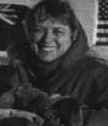
|
The
story of the
American woman
doctor who
discovered a
fast-growing
cancer in her body
while at the
height of the
winter season at
the South Pole
gripped much of
the world in the
Antarctic winter
of 1999-2000. Dr.
Jerri Nielsen
wrote a book in
which she gave
inspiration to her
two "dead
doctors,"
pioneer Antarctic
physician
explorers
Frederick A. Cook
and Edward Wilson.
Serving
as doctor to the
Americans
"wintering
over" at the
South Pole in
1999, Dr. Nielsen
made headlines
when she
discovered a lump
in her breast that
a
self-administered
biopsy revealed to
be cancer. No
flights in or out
of Antarctica are
possible during
the continent's
long winter, and
Nielsen's account
of giving herself
chemotherapy while
she and her fellow
"Polies"
waited for the
weather to break
is even more
gripping than the
news reports at
the time. She's
candid about her
pain and fear; the
media battle waged
by her embittered
ex-husband made
her ordeal even
more challenging.
>
READ
THE FULL ACCOUNT
|
|
|
|
Saving
the pioneer U.S.
icebreaker 'Glacier' |
|
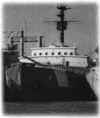
|
The
USS/USCG Glacier
made Antarctic
history in
February 1960 by
becoming the first
ship to penetrate
the Bellinghausen
Sea (where Cook
wintered in
1898-99) and make
landfall on
Thurston Island.
Four decades
later, the Glacier
is moored in
Suisun Bay, CA at
the Maritime
Admin-istration's
Defense Reserve
Fleet Facility.
However, the
Glacier Society, a
Stratford, CT
based group, hopes
to change her
fate. Their goal
is to restore the Glacier
to an educational
resource as a
museum and
operational
oceanographic
research
community, in port
and at sea.
>
READ
THE FULL ACCOUNT
|
|
|
|
| Additional
Newsletter
Highlights:
April 2001 |
|
|
- 'My
Attainment of
the Pole' in two
90th anniversary
reprint editions
- Verdict
of 20th century
scholars, and
geographers
- Recalling
Cook's decade in
Toms River
|
|
|
|
New
Zealand Expedition
Confirms Cook
Observations |
|
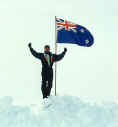
|
In
1996, Richard
Reaney, a veteran
of both Polar
regions, led a
nine-member
expedition from
New Zealand to
place their flag
at the North Pole
for the first
time. In a letter
to the Society, he
wrote that
"on the 21st
of April 1996, the
88th anniversary
of Cook's arrival
at the Pole...we
determined that
Cook's sextant
readings (are now)
determined by
modern
navigational
data."
As
a member of the
Commemorative
Centennial
Circumnavigation
of the Antarctic
in 1994, Rainey
had a discussion
with Sir Edmund
Hillary which led
to their
expedition to the
Pole two years
later. The
party determined
to journey to the
Pole to be there
on Cook's arrival
date of April 21,
for "nowhere
could we find if
anyone had gone to
the Pole to
confirm Cook's
observations--on
exactly the same
day and the same
time. We
discussed our
plans with Wayne
Davidson, then at
Eureka Weather
Station and I
believe we have
found good reason
to support
(Cook's) findings
and his
observations."
>
READ
THE FULL ACCOUNT
|
| . |
|
|
Computing
Refraction Data
at the North Pole:
1908/2000 |
|
 |
Wayne
Davidson, the
upper air station
weather operator
at Resolute Bay,
in Nunavut, in the
Canadian high
Arctic, presents a
theory that
"historical
allegations at
being close to the
North Pole are
provable."
Davidson, who has
provided weather
data to virtually
every private and
government-sponsored
expedition to the
Western region of
the Polar Sea in
the past decade,
maintains that the
only way to
validate the
claims of Robert
Peary and
Frederick Cook
"is by
analyzing results
from the sole
instrument they
have used to get
them to the
Northernmost piece
of earth, the
sextant."
In
a two-part
contribution,
Davidson utilizes
the field notes
and published
accounts of both
explorers and
declares that
"newer Polar
refraction tables
can pin point with
higher accuracy
Cook and Peary's
locations (in 1908
and 1909)."
He cites data from
the Nautical
Almanac Office of
the US Naval
Observatory as
well as other
published and
analytical data on
Cook and Peary.
>
READ
THE FULL ACCOUNT
|
|
|
|
| Newsletter
Highlights:
December 2000 |
|
|
- Cook
in 'Echoes in
Ice' Exhibition
at Ohio State
University
Library
- New
board member Lon
Constantini has
Arctic motto:
'think coldly,
act warmly'
- Polar
& Alpine
Medicine Report
is published
- President's
Message:
Untapped
treasure of
'Hell is a Cold
Place'
- Videotaping
the Society's
Historian/
Revamping the
Cook Web Site
- To
the Ends of
Earth:' Chicago
Newberry Library
explores Polar
discovery
- Book
review:
'Let Heroes
Speak: Antarctic
Explorers,
1772-1922"
|
Copyright
2007 - The Frederick A.
Cook Society
|